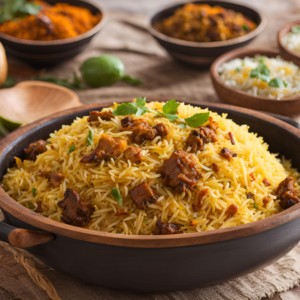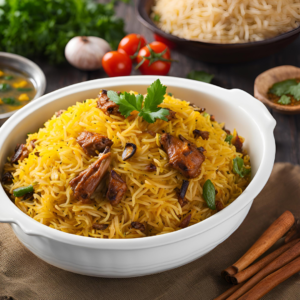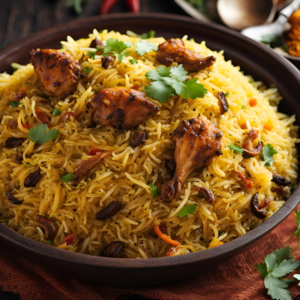Biryani A fragrant rice dish cooked with spices, meat (like chicken, mutton, or beef), and sometimes vegetables. Biryani is known for its complex flavors and rich aroma
Biryani is a richly aromatic and flavorful rice dish that has become a global favorite. Originating from the Indian subcontinent, this dish is known for its complex blend of spices, fragrant basmati rice, and a variety of ingredients such as marinated meats, vegetables, or seafood. Each region has its own version of biryani, adding unique local flavors and techniques. Traditionally served during special occasions, biryani has become a staple in everyday cuisine as well, thanks to its satisfying and flavorful profile.
Ingredients:
For the Marinade:
- 500g chicken (or beef, lamb, or vegetables), cut into pieces
- 1 cup plain yogurt
- 2 tablespoons ginger-garlic paste
- 1 tablespoon red chili powder
- 1 teaspoon turmeric powder
- 1 teaspoon garam masala
- Salt to taste
For the Rice:
- 2 cups basmati rice
- 4 cups water
- 2-3 cloves
- 1-2 cardamom pods
- 1 bay leaf
- Salt to taste
For the Biryani:
- 2 tablespoons ghee (clarified butter) or oil
- 1 large onion, thinly sliced
- 2 tomatoes, chopped
- 2-3 green chilies, slit
- 1 teaspoon cumin seeds
- 1 teaspoon coriander powder
- 1 teaspoon biryani masala or garam masala
- A few mint leaves
- A few coriander leaves
- 1/4 cup saffron milk (a few strands of saffron soaked in warm milk)
- Fried onions (optional, for garnish)
Instructions:
Marinate the Meat or Vegetables:
- In a bowl, mix yogurt, ginger-garlic paste, red chili powder, turmeric powder, garam masala, and salt.
- Add the meat or vegetables and coat well. Cover and refrigerate for at least 1 hour (overnight is preferable).
Cook the Rice:
- Rinse the basmati rice under cold water until the water runs clear.
- In a large pot, bring 4 cups of water to a boil. Add cloves, cardamom pods, bay leaf, and salt.
- Add the rice and cook until it is 70% cooked. Drain and set aside.
Prepare the Biryani Base:
- Heat ghee or oil in a large pan over medium heat.
- Add cumin seeds and allow them to splutter. Add sliced onions and sauté until golden brown.
- Add chopped tomatoes and green chilies, and cook until the tomatoes are soft.
- Stir in the marinated meat or vegetables and cook until they are tender and the oil separates from the mixture.
Layer the Biryani:
- In a heavy-bottomed pot, layer half of the partially cooked rice over the meat or vegetable mixture.
- Sprinkle with half of the biryani masala or garam masala, mint leaves, and coriander leaves.
- Add the remaining rice and repeat the layering with the remaining spices, mint, and coriander.
- Drizzle saffron milk over the top layer.
Dum Cooking (Final Steaming):
- Cover the pot with a tight-fitting lid or seal with dough to trap the steam.
- Cook on low heat for 20-25 minutes to allow the flavors to meld and the rice to finish cooking.
Serve:
- Gently fluff the biryani with a fork and serve hot. Garnish with fried onions if desired.
Nutritional Information (per serving, approx. 250g):
- Calories: ~350-400 kcal
- Proteins: ~20-25g (depending on the type and amount of meat used)
- Carbs: ~45-55g
- Fiber: ~2-4g
Nutritional Summary:
Biryani is a hearty dish that provides a good balance of protein from the meat or vegetables and carbohydrates from the rice. It is rich in flavors but also relatively high in calories, largely due to the ghee or oil used in cooking. The fiber content varies depending on the vegetables added and the type of rice used. While biryani is a satisfying meal, it is best enjoyed in moderation, especially if you’re mindful of calorie intake



